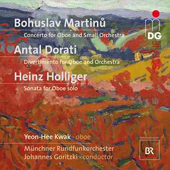
COLLECTIONS

The Korean oboist Yeon-Hee Kwak, who's been dubbed the "Paganini of the Oboe", tackles three demanding 20th century works for this diminutive but extremely versatile
instrument. The informative liner notes by Klaus Döge point out that Richard Strauss once said: "The oboe can buzz, bleat and screech, just as it can sing and lament nobly and chastely,
play with childlike gaiety and sound like a shawn." All these characteristic traits and more are readily apparent and put to the test in these ambitious and varied compositions.
Bohuslav Martinu had a knack for combining old and new forms and styles seamlessly, and this Concerto for Oboe and Small Orchestra from 1955 is a prime
example of this aptitude. With extremes from virtuosic episodes to tender and lyrical passages, it places high demands on the soloist, and Yeon-Hee Kwak leaps over any hurdle with ease
and always maintains a musical delivery even under the heaviest pressures. The series of consecutive trills in the last movement could be enough to discourage even the most competent
performers, but not this one. The whole impressive work is delivered with energy, wit, flair, tenderness and an almost vocal quality to the sound of the instrument.
One of the great oboists of our times, Heinz Holliger composed his Sonata for Oboe solo for himself in 1957. Any extended piece for a solo wind instrument
demands a confident breathing technique and a multi-faceted delivery for it to become an engrossing and compelling piece of music without drawing negative attention to the instrument
itself. Yeon-Hee Kwak achieves exactly that and more, and delivers a focused account that never veers off into mediocrity.
The conductor Antal Dorati wrote his Divertimento for Oboe and Orchestra in 1976. The work is scored for a small orchestra including an unusual
combination of odd percussion instruments including sandpaper. As the liner notes indicate, it was written to be an amusing piece of entertainment in the 18th century sense. The
individual movement nomenclatures certainly fit the period, Menuetto, Toccata, Preludio, but in actual fact, it is the most modern sounding work on the CD. It is an imaginative
mix of past and future that gives the soloist plenty of freedom of expression and moments to exploit the instrument's versatility at every turn.
A highly recommendable recording for those who enjoy the oboe, or for those who enjoy a well written concerto, or for those who enjoy 20th century composers, and even for those who
enjoy a combination of all the above. A varied program that covers all the bases and includes fine musicianship from all parties involved. Another impressive MDG 2+2+2 recording that
can be played on a conventional CD player, DVD Video, DVD Audio and multichannel Super Audio CD player.
Jean-Yves Duperron